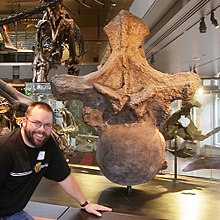
Back Titanosauria Afrikaans تيتانوصوريات Arabic تيتانوصوريات ARZ Titanosaures Catalan Titanosauria Czech Titanosaur Danish Titanosaurier German Titanosauria English Titanosauria Spanish تیتاناسور Persian
| Titanosaurs Temporal range: Cretaceous 140–66 mya
| |
|---|---|

| |
| Epachthosaurus skeleton, National Museum, Czech Republic, originally from South America | |
| Scientific classification | |
| Kingdom: | |
| Class: | |
| Superorder: | |
| Order: | |
| Suborder: | |
| Infraorder: | |
| Superfamily: | †Titanosauroidea Lydekker, 1895
|
| (unranked): | †Titanosauria Bonaparte & Coria, 1993
|




Titanosaurs were a group of large sauropod dinosaurs. Together with the brachiosaurs and relatives they make up the larger clade Titanosauriformes.
They were the largest and heaviest creatures ever to walk the Earth.[1] Titanosaurs included Saltasaurus, Isisaurus, and Paralititan. The group includes the largest land animals known to have existed. Patagotitan – (37 m (121 ft) long) – is now installed in the Natural History Museum in London.[2] Its weight in life is estimated at 69 tonnes (76 tons).[3]
The comparably sized Argentinosaurus and Puertasaurus are from the same region, as is Abdarainurus and Aegyptosaurus. The group's name is from the mythological Titans of Ancient Greece.
The titanosaurs were the last great group of sauropods before the Cretaceous–Paleogene extinction event. They were the dominant herbivores of their time. The fossil evidence suggests they replaced the other sauropods: the diplodocids and the brachiosaurids died out between the Upper Jurassic and the mid-Cretaceous.
- ↑ BBC David Attenborough program: [1]
- ↑ Giant dinosaur slims down a bit. BBC News Science & Environment
- ↑ Carballido, J.L.; Pol, D.; Otero, A.; Cerda, I.A.; Salgado, L.; Garrido, A.C.; Ramezani, J.; Cúneo, N.R.; Krause, J.M. (2017). "A new giant titanosaur sheds light on body mass evolution among sauropod dinosaurs". Proceedings of the Royal Society B: Biological Sciences. 284 (1860): 20171219. doi:10.1098/rspb.2017.1219. PMC 5563814. PMID 28794222.